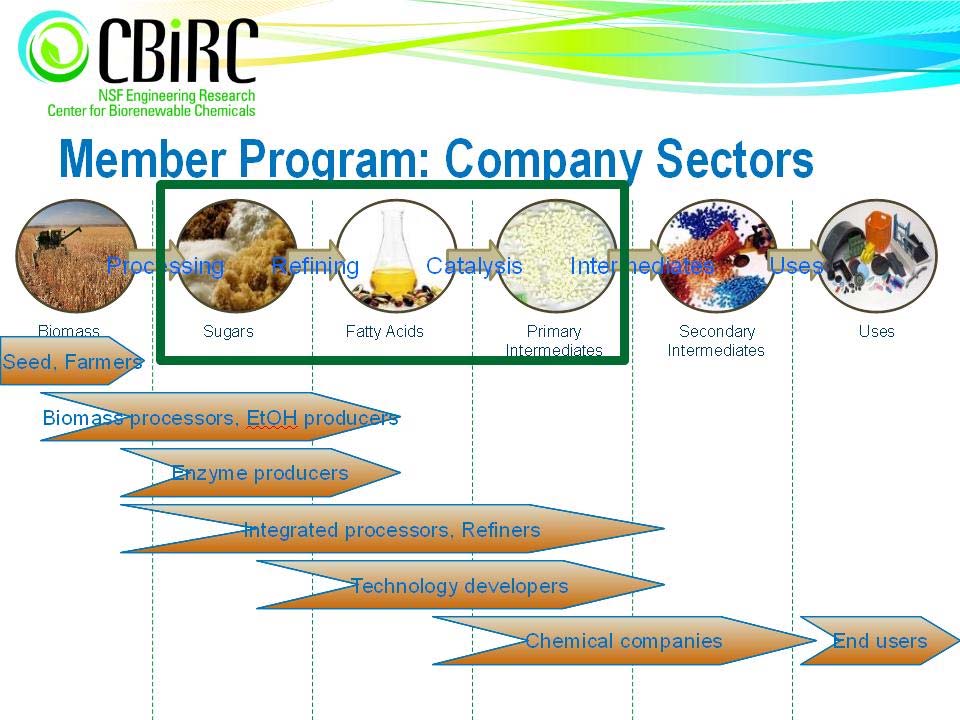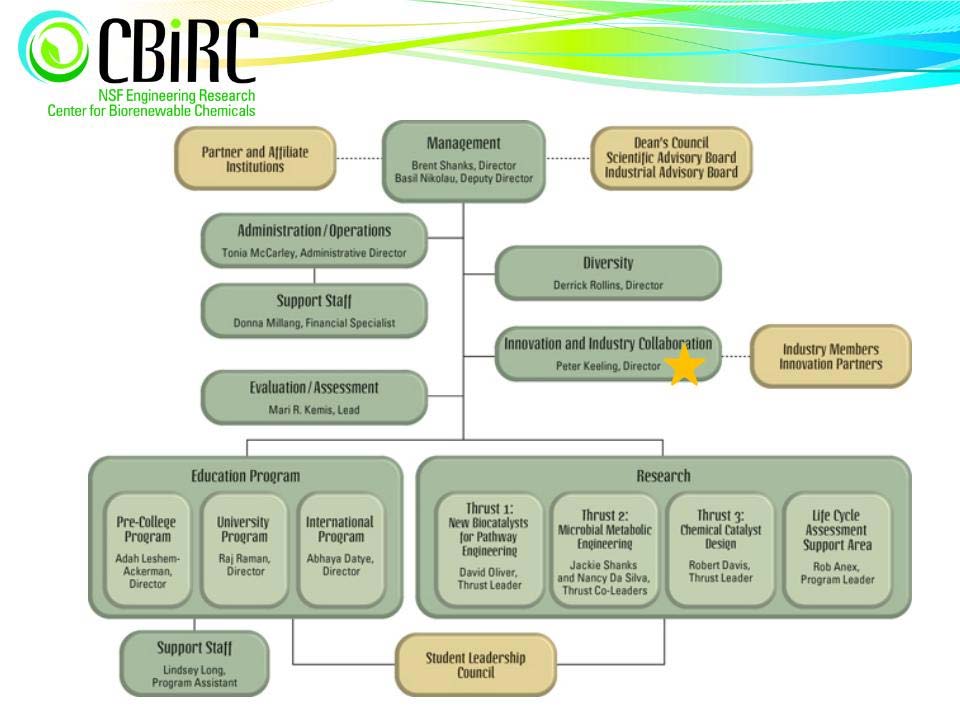3.6.1 Gen-3 ERC Features
Driven primarily by the goal of actively stimulating technological innovation, NSFâs new third-generation (Gen-3) ERCs are characterized by features including the following (see Endnote 1):
- Advancement of cross-disciplinary, transformational research and engineered systems through engagement with small firms
- Partnerships with member firms and organizations dedicated to stimulating entrepreneurship and speeding technological innovation
- Development of an engineering workforce that is innovative and globally competitive
- Partnerships with foreign universities to provide cross-cultural, global research and education experiences
- Long-term partnerships with middle schools and high schools to bring engineering concepts to the classroom, thereby increasing interest in future enrollment in college-level engineering programs.
Because these Gen-3 features rest on the core ERC construct common to all ERCs, many best practices for earlier ERCs will prove useful for Gen-3 centers. Nevertheless, some Gen-3 featuresâparticularly funding small start-up firms for translational research from the ERC base budget, and partnerships with foreign universities and pre-college schoolsâcould suggest substantial changes to past best practices. The paragraphs below illustrate several situations.
3.6.2 Some Gen-3 Situations that Might Require Change from Past Best Practices
Consider, for instance, the best practices associated with the major topics of this chapter: preparing and executing a strategic plan and integrating research with industry and with education. There may be little difference between Gen-3 ERCs and prior ERCs in which researchers are located at several geographically dispersed locations in the United States. However, when one includes foreign universities, that introduces a new dimension.
For example, communications involving foreign universitiesâeven if by phone or âgo-to-meetingâ or sophisticated video teleconferencingâcould be difficult because of the very different time zones. But time-zone problems may be small compared to cultural and administrative differences between U.S. practices and those of foreign universities. For example, aspects of the following best practices for research thrust leaders could become substantially more complicated:
- Defining responsibilities and authorities for organizations and individuals
- Creating and sustaining buy-in
- Reaching decisions on budgets and resource allocations when the foreign component has to be funded by foreign sources of funds
- Deciding on deliverables and their schedules
- Establishing appropriate metrics
- Agreeing on financial terms and intellectual-property issues
- Resolving conflicts between research and industrial products
- Maintaining balance in education exchanges.
Similarly, dealing with pre-college schools could also complicate matters (the above section on integrating research and education recognizes K-12 affiliations). There is great interest within the United States on furthering STEM (science, technology, engineering, and math) education for young students. Nevertheless, preparing and executing strategic plans and integrating industrial firms (especially small ones) not only with U.S. and foreign educators but also with middle- and high-school teachers, is challenging for Gen-3 ERCs.
3.6.3 So What Is Needed?
It is apparent that some of the best practices delineated earlier in this chapter will need to be changed to accommodate certain Gen-3 features. Lessons learned from the early years of Gen-3 operations will shed light on just what changes are necessary. Therefore, a suggested best practice for start-up Gen-3 ERCs would be to document the kinds of best-practice changes they find necessary to accommodate the special features of Gen-3 operations.
However, there are other sources for best practices than ERCs themselves. At least two other groups come to mind.
First, many U.S. businesses operate on a global scale. They too prepare and execute strategic plans of global scope, and some also likely have ties of one kind or another to foreign universities. Several of these businesses should be good sources of best practices for the Gen-3 personnel (see Endnote 8).
Second, with all the U.S. interest in STEM education for pre-college students, several organizations could suggest best practices to the Gen-3 personnel. These organizations would include various entities in or associated with the Department of Defense (see Endnote 9) as well as the House of Representativesâ STEM Caucus and STEM Caucus Steering Group.
When there is sufficient experience upon which to build a set of best practices for Gen-3 ERCs, revisions to this chapter and others in the Best Practices Manual will be developed and released.
3.6.4 Items of Particular Relevance
In late 2010 and early 2011, many additional comments relating to Gen-3 ERCs were received. This subsection summarizes those comments. To start, several important messages appear below. These are amplified in following paragraphs.
â... agree with the speculated differences and also with the approach of allowing real experiences to develop and be incorporated later.â
â[XXX University] will not allow us to enter into any export control licenses as these represent restrictions on academic freedoms. Instead we have had to find routes to basic research exemptions to export control. In a recent project in [YYY], we had to construct a locked structure to secure our testbed and hire a guard to monitor access to the prototype 24/7. Also, only US citizens were allowed to operate the equipment in [YYY] â except for one [YYY] student who had fortunately been trained on the equipment in [XXX University] during the prior year.â
âA major issue we have encountered to date is mentioned â how to work with the foreign collaborators when you cannot provide a direct fiscal incentive. We don't have it successfully solved yet, but are trying.â
Concerns exist regarding intellectual-property issues and research-versus-product conflicts.
Significant differences exist between Gen-3 and Gen-2 ERCs relative to integration with industry (see introductory comments in Section 3.4).
Export Controls. As noted above, Gen-3 ERCs need to pay particular attention to potential International Traffic in Arms Regulations (ITAR) and Export Control issues. Export Control restrictions are especially challenging when it comes to operating testbeds in foreign countries, even in countries that are considered friendly allies. Beyond the complexities of sending prototypes lacking U.S. security classifications, export controls restrict information flows as well. For example, foreign students might be trained on U.S.- based testbeds, but foreign students at a foreign partner institution might not be allowed to train on the exact same testbed outside the United States.
Working with Foreign Collaborators. With respect to creating and sustaining buy-in, experience suggests that foreign-partner involvement is usually developed because of a specific relationship between individual ERC faculty and a collaborator at a foreign partner. Leveraging that professional relationship tends to create the most functional interactions. With respect to the possibility of learning from U.S. businesses that operate on a global scale, management of export-control issues remains critical (see above). Industrial processes for managing global technology interactions may or may not be applicable in academic situations, which require preventing information flow between U.S. and foreign subsidiaries except through carefully structured legal agreements and joint-venture arrangements. Some U.S. universities have detailed guidelines, others don't. With respect to working with foreign educators, finding ways to leverage foreign STEM initiatives could be attractive to U.S. educators. One challenge with also integrating smaller firms is that they are typically very lean and don't have the band-width for these types of initiatives unless there is support from their investors (probably a better place to engage).
Intellectual Property Relative to Start-ups and Small Firms. Gen-3 ERCs are expected to have active start-up/innovation infrastructure, which may bring the ERC industry members' rights to intellectual property into conflict with fostering home-grown start-up firms, especially if exclusive intellectual-property rights are needed for start-up survival. One comment noted that, in a survey conducted last year, many of the Gen-3 ERCs did not have specific policies and procedures to navigate these âuncharteredâ waters, especially when the start-ups cannot afford to pay membership fees at a level comparable to existing member firms. Another comment indicated that, although the notion of an ERC playing an âangelâ role in start-up funding is being considered, it is highly unlikely that the funding levels being considered would ever be large enough to have an impact on start-up viability. It needs to be recognized that small, high-technology firms are frequently unwilling to risk diluting their intellectual-property-generation capability by partnering with an ERC developing intellectual property in a space the small firms consider their own. This situation has been encountered with small firms looking at the ERC core (most transformational) programs.
Resolving Research-versus-Product Conflicts. Relative to resolving conflicts between research and industrial products, clear delineation between core ERC research and development (accessible by all ERC industrial members) and non-core, synergistic-sponsored (or more applications-specific) research is important. Synergistic research can also be sponsored in particular areas to speed technology innovation and transfer.
Gen-3 Integration with Industry. One person from a Gen-3 ERC contributed valuable comments by means of a slide presentation. The presentation was specifically oriented at Section 3.4, which addressed best practices for integrating research and industry. Because Gen-3 is the primary focus of Section 3.6, it was deemed best to include elements of that presentation here.
- Best practices for Gen-3 ERCs should explicitly recognize inclusion of innovation/venture partners in addition to industrial partners. Such partners can bring significant opportunities for early stage innovations to materialize (e.g., through start-ups).
- In light of the importance of innovation/venture partners, best practices for Gen-3 ERCs should also include recognition of the Industrial Collaboration and Innovation Director (ICID) as well as appropriate interactions between this Director and research thrust leaders (e.g., the Director manages and the thrust leaders assist).
- Depending on the Gen-3 ERC, some intellectual-property issues may be taken care of by the ICID.
- Regarding portfolio balance, communications, roadblocks, and industrial collaboration, there should be general sharing of best practices between the ICID (broader, across-ERC issues) and individual thrust leaders (primarily within-thrust issues).
- Perhaps a workshop day could be set up to acquaint industry employees at one end of a process spectrum to a basic overview of research and technology at the other end of the process spectrum.
The three charts below furnish an overview of the ERC for Biorenewable Chemicals (CBiRC), the Gen-3 âprocess centerâ that was a basis for these suggestions. Note ICID (starred) in second chart.


CBiRC INDUSTRY MEMBERS AND PARTNERS
Industry Members: Allylix, Ashland, Chevron Phillips, Cibus, Danisco, DSM, Elevance Renewable Sciences, Genomatica, Grain Processing Corporation, Glycos Biotechnology, Novozymes, Poet Energy, Solazyme, The BioBusiness Alliance Minnesota
Innovation Partners: BioCentury Research Farm, Biomass Energy Conversion Facility, Center for Crops Utilization Research, Iowa Department of Economic Development, Iowa Values Fund, Iowa Demonstration Fund, Local Seed/Angel Funds, Pappajohn Center for Entrepreneurship, University Research Park, University Entrepreneurship Courses, University Offices of Intellectual Property, University/State Business Plan Competition
Venture Partners: Illinois Ventures, Khosla Ventures, Kleiner Perkins Caufield & Byers, Equity Dynamics, Mayfield Fund, Cimarron Capital

